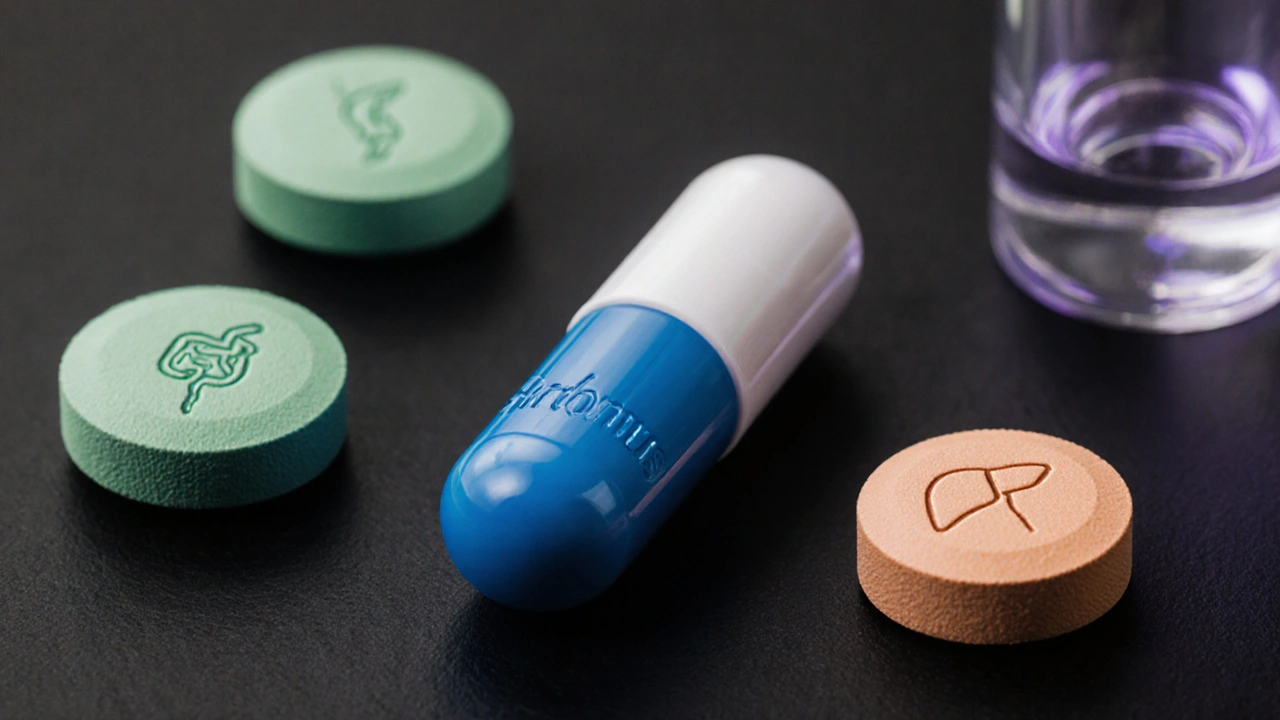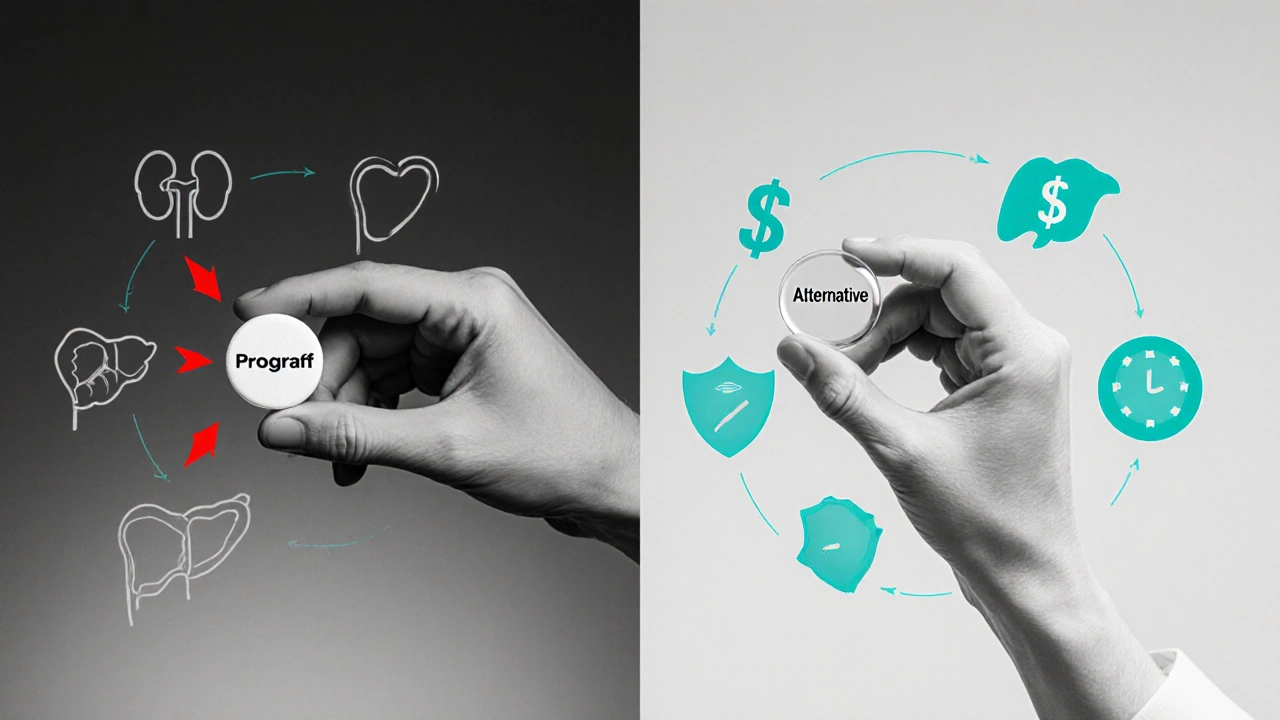Immunosuppressant Side Effect Risk Calculator
Patient Risk Profile
When a transplant patient or clinician needs to pick an immunosuppressant, the choice isn’t just about “which pill works.” Safety, side‑effects, dosing convenience, and cost all clash in the final decision. Prograf alternatives are therefore a hot topic for anyone navigating post‑transplant care.
What is Prograf (Tacrolimus)?
Prograf is the brand name for Tacrolimus, a calcineurin inhibitor that suppresses T‑cell activation to prevent organ rejection. Approved in 1994, it quickly became the go‑to drug for kidney, liver, and heart transplants because of its potency and relatively rapid onset. The typical oral dose ranges from 0.1mg/kg to 0.3mg/kg per day, adjusted to maintain blood trough levels between 5-15ng/mL depending on the organ type.
Why Look for Alternatives?
Even though Prograf is effective, it carries a hefty side‑effect profile: nephrotoxicity, neurotoxicity (tremors, headaches), diabetes risk, and high blood pressure. Some patients also develop resistance or intolerable side effects, prompting doctors to consider other immunosuppressive options. Cost is another driver-generic tacrolimus exists, but insurance coverage can vary widely.
Key Decision Criteria
- Efficacy: How well does the drug prevent acute and chronic rejection?
- Safety: Frequency and severity of organ‑specific toxicities.
- Pharmacokinetics: Dosing frequency, need for blood‑level monitoring.
- Drug Interactions: Compatibility with other post‑transplant meds (e.g., azoles, antibiotics).
- Cost & Insurance: Out‑of‑pocket expense and formulary status.
- Patient Lifestyle: Convenience, pill burden, and ability to adhere.
Major Alternatives to Prograf
Below are the most commonly considered drugs when clinicians need a backup or a combination regimen.
Sirolimus (Rapamune)
Sirolimus is an mTOR inhibitor that blocks T‑cell proliferation downstream of IL‑2 signaling. It is often paired with low‑dose tacrolimus or used as a calcineurin‑sparing option. Typical dosing starts at 2mg daily, aiming for trough levels of 5-15ng/mL. It’s less nephrotoxic than tacrolimus but may cause hyperlipidemia, delayed wound healing, and mouth ulcers.
Mycophenolate Mofetil (CellCept)
Mycophenolate mofetil (MMF) antagonizes inosine monophosphate dehydrogenase, curbing guanine synthesis in lymphocytes. It’s a staple in triple‑therapy regimens. The usual dose is 1g twice daily. Side‑effects include GI upset, leucopenia, and increased infection risk, but it spares the kidneys.
Azathioprine (Imuran)
Azathioprine is a purine analog that interferes with DNA synthesis in rapidly dividing cells, including T‑ and B‑lymphocytes. Dosed at 1-2mg/kg/day, it is cheaper but less potent than MMF. Myelosuppression and liver enzyme elevation are its main concerns.
Belatacept (Nulojix)
Belatacept is a fusion protein that blocks CD80/CD86 costimulation, preventing full T‑cell activation. Delivered intravenously every 4 weeks after an initial loading phase. It offers superior long‑term renal function compared to calcineurin inhibitors, yet its cost and infusion requirement limit widespread use.
Corticosteroids (Prednisone)
Prednisone remains a backbone of most regimens for its broad anti‑inflammatory action. While not a direct substitute for tacrolimus, dose tapering strategies often involve shifting reliance to other agents.

Side‑Effect Profile at a Glance
| Drug | Renal Impact | Metabolic Concerns | Other Notable Toxicities |
|---|---|---|---|
| Prograf (Tacrolimus) | Nephrotoxic (dose‑dependent) | Diabetes, hyperlipidemia | Tremor, headache, neurotoxicity |
| Sirolimus | Renal‑sparing | Hyperlipidemia, insulin resistance | Delayed wound healing, mouth ulcers |
| Mycophenolate Mofetil | Renal‑sparing | Less metabolic impact | GI upset, leukopenia, infections |
| Azathioprine | Renal‑sparing | Variable; may affect glucose control | Hepatotoxicity, bone marrow suppression |
| Belatacept | Renal‑protective | Minimal metabolic issues | Infusion reactions, PTLD risk |
| Prednisone | Potentially nephrotoxic in high doses | Weight gain, diabetes, osteoporosis | Hypertension, mood swings |
Cost & Accessibility Overview
Cost is a practical gatekeeper. Generic tacrolimus averages $2‑$4 per tablet in the U.S., but insurance formularies often place it in a higher tier, leading to higher co‑pays. Generic MMF is cheaper at $0.50‑$1 per 500mg tablet, while sirolimus sits around $8‑$12 per tablet. Belatacept, being a biologic, can exceed $2,000 per infusion. Azathioprine remains the most affordable at $0.10‑$0.30 per 50mg tablet. Internationally, pricing varies dramatically, and some countries subsidize tacrolimus more heavily than sirolimus.
Best‑Fit Scenarios
- Renal transplant patients with declining graft function due to tacrolimus nephrotoxicity: Switch to sirolimus or belatacept, both of which are gentler on the kidneys.
- Patients experiencing tremor or neuro‑symptoms on Prograf: Consider MMF combined with a lower calcineurin inhibitor dose or an mTOR blocker.
- Cost‑conscious patients with stable graft function: Azathioprine or generic MMF may provide sufficient immunosuppression at a fraction of the price.
- Patients needing fast‑acting rescue therapy after acute rejection: High‑dose tacrolimus remains the most rapid option.
- Those with contraindications to calcineurin inhibitors (e.g., severe hypertension, uncontrolled diabetes): Belatacept offers a calcineurin‑free pathway.

Practical Tips for Switching Therapies
- Assess baseline labs: Creatinine, liver enzymes, lipid panel, and fasting glucose give a safety window.
- Determine overlap period: For tacrolimus to sirolimus, maintain low‑dose tacrolimus for 7‑10days while titrating sirolimus to target trough.
- Monitor drug levels: Tacrolimus and sirolimus require therapeutic drug monitoring; MMF and azathioprine do not.
- Educate patients on new side‑effects: Hyperlipidemia with sirolimus, GI symptoms with MMF, infection risk with belatacept.
- Re‑evaluate in 4‑6 weeks: Look for graft function stability, any new adverse events, and adherence.
Frequently Asked Questions
Can I stop Prograf completely and rely only on MMF?
Most transplant protocols keep a low‑dose calcineurin inhibitor even when MMF is added, because MMF alone may not prevent acute rejection in high‑risk patients. A complete switch is usually reserved for patients with proven tolerance and stable graft function for at least a year.
Is generic tacrolimus as effective as brand‑name Prograf?
Yes, FDA‑approved generics meet the same bioequivalence standards. Clinical studies in kidney and liver transplants have shown comparable rejection rates. However, some clinicians report subtle differences in trough variability, so monitoring may need to be tighter during the switch.
What are the main advantages of belatacept over tacrolimus?
Belatacept preserves long‑term kidney function better because it avoids calcineurin‑induced nephrotoxicity. It also reduces the risk of new‑onset diabetes after transplant. The downsides are higher cost and the need for monthly IV infusions.
How does sirolimus affect wound healing after surgery?
Sirolimus impairs the mTOR pathway, which is essential for cell proliferation and angiogenesis. Consequently, patients may experience delayed wound closure, dehiscence, or incisional hernias. Surgeons often hold sirolimus 5‑7 days before major operations and restart it once the wound is stable.
Are there any diet restrictions when taking tacrolimus?
Tacrolimus levels can rise with high‑fat meals or grapefruit juice, which inhibit CYP3A4 metabolism. Consistency is key-take the drug at the same time each day with the same type of meal, and avoid large grapefruit quantities.
Bottom Line
Choosing a Prograf alternative isn’t a one‑size‑fits‑all decision. It hinges on how the patient’s kidney is doing, their metabolic profile, insurance coverage, and personal preferences. By weighing efficacy, safety, cost, and convenience, clinicians can tailor a regimen that keeps the transplanted organ thriving while minimizing the burden on the patient.


Cinder Rothschild
October 15, 2025 AT 13:34When I think about transplant medication I see a tapestry of choices woven across borders. The history of tacrolimus began decades ago and its impact rippled worldwide. Patients in Canada often weigh the cost against the benefit like a delicate scale. The brand name Prograf carries a reputation that transcends language. Yet generic tacrolimus offers similar potency without the premium label. The alternatives such as sirolimus rapamune and belatacept nulojix each bring their own story. Sirolimus for example spares the kidneys and invites a different side effect profile. Belatacept delivers a biologic infusion that can protect renal function over the long haul. Mycophenolate mofetil cellcept is a staple in many triple therapy regimens and is affordable for many families. Azathioprine remains a cost effective option that has served generations of patients. The decision to switch often hinges on personal health goals and cultural attitudes toward medication. In some cultures the idea of an IV infusion like belatacept is met with hesitation while oral pills are embraced. Others prioritize newer technology even if it means higher out of pocket expense. The clinician must balance scientific evidence with patient lifestyle and cultural expectations. Understanding these nuances can turn a daunting choice into an empowered journey.
Oscar Brown
October 15, 2025 AT 13:51Your exposition invites a deeper reflection on the epistemology of therapeutic choice. The clinician, as a steward of graft survival, must reconcile empirical data with the phenomenology of patient experience. Tacrolimus, while potent, imposes a metabolic burden that resonates through the endocrine axis. Alternatives such as sirolimus or belatacept embody a divergent mechanistic ontology that may alleviate renal insult. Yet the philosophical question persists: does the reduction of nephrotoxicity justify the elevation of immunologic risk? One must also consider the ontological cost of infusion logistics inherent to belatacept. The cost dimension, though material, intersects with notions of justice and equitable access. In sum, the decision matrix resembles a dialectic where each variable negotiates its place in the final synthesis. Such a dialectic demands rigorous monitoring and an unwavering commitment to patient-centered ethics.
Tommy Mains
October 15, 2025 AT 14:24That’s a solid overview and it’s useful to keep the basics in mind. For most patients the first step is to check kidney labs and blood sugar before changing meds. If the graft is stable you can consider moving to a renal‑sparing drug like sirolimus or azathioprine. Remember to keep the dose low at first and watch the trough levels closely. Talk with the transplant team about insurance coverage so the cost doesn’t become a surprise.
Inma Sims
October 15, 2025 AT 14:58I applaud the thoroughness while simultaneously questioning the need for such academic grandstanding. Clearly, the sheer volume of data could overwhelm anyone who merely wishes to survive a transplant. Your table, though exhaustive, reads like a saga one might expect from a pharmaceutical brochure. One might wonder whether patients have time to parse hyperlipidemia versus mouth ulcers amidst recovery. Nevertheless, the sarcasm notwithstanding, the clinical pearls are not lost on me. A concise, patient‑focused summary would perhaps serve better than a laboratory‑report style monologue.
Gavin Potenza
October 15, 2025 AT 15:48Honestly, the whole landscape feels like a philosophical puzzle where every piece has a hidden price tag. You can argue that the best drug is the one that lets you binge‑watch your favorite shows without a kidney flare. On the other hand, the long‑term health of the graft is something you can’t just shrug off. I tend to lean toward a hybrid approach – low‑dose tacrolimus paired with MMF to keep the immune system in check while sparing the kidneys. It’s not the flashiest plan, but it’s pragmatic. Cost, side‑effects, and lifestyle all converge in that decision. In the end, the patient’s daily reality should steer the ship.
Hariom Godhani
October 15, 2025 AT 16:54It is an utter tragedy that so many patients are lured into the false promise of brand‑name magic while ignoring the humble power of generic alternatives. The medical establishment peddles expensive biologics like belatacept as if they were miracles, yet the evidence remains tenuous at best. One must condemn the complacency that allows nephrotoxic tacrolimus to dominate the market despite its well‑documented harms. The drama unfolds as clinicians juggle profit, prestige, and patient welfare, often at the expense of the latter. I implore you to awaken to the moral imperative of prescribing what truly benefits the graft, not what fattens pharmaceutical ledgers. The cost‑benefit analysis should be brutally honest, unclouded by marketing hype. Only then can we break the cycle of unnecessary toxicity. The stakes, after all, are nothing short of life itself.
Jackie Berry
October 15, 2025 AT 18:18I often sit back and watch the conversation unfold, appreciating how many angles there are to consider. From a cultural standpoint, patients in different regions view oral pills versus IV infusions through very different lenses. The balance between efficacy and day‑to‑day convenience makes each case unique. It’s fascinating to see how a simple table can spark such diverse perspectives.
Mikayla May
October 15, 2025 AT 19:58Just a heads‑up, make sure you monitor lipid levels if you’re moving to sirolimus. It tends to raise cholesterol more than tacrolimus.
Jimmy the Exploder
October 15, 2025 AT 21:54Nice overview but way too long